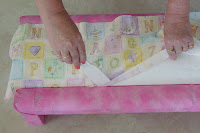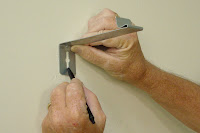
We talk alot about the fact that the Window Bonnets cornice is No Sew. In other words, it does not require a sewing machine for you to prepare the fabric for application to the cornice board. However, you might be asking "What tools does it take? It must take some tools."
You are right, there are a couple of tools that are needed, but primarily for the hanging of the cornice. Let's take them in order.
1. A full-size LOW temperature glue gun. A full-size one is needed to be able to put enough glue along the edge and center before it begins to seriously set. The 9" high cornice can be made using the smaller craft size guns. But always use a LOW temperature gun or the glue will quickly melt the styrofoam material. I do sell these on my site as a convenience. I generally also include 3-5 10" sticks depending on how many cornices are purchased.
2. A hand drill, battery operated, or plug-in with a 1/8" drill bit. Very important, you do not have to find the stud in the wall. If the drill bit hits only drywall, no problem, just use the screw sleeve that is provided with the kit to tightly secure the screw in the wall. If you hit the metal rim around the window you will not need to use the screw sleeve.
3. Standard phillips-head screw driver. Now this one might not be needed if your drill is strong enough to turn the screw tightly. If not, you may need to use a bit of "hand" power to do the finally tightening.
4. Hammer, generally used to get the screw sleeve installed, but you might also want to use it with a punch/scribe to make a small indent in the wall marking the position for the drill.
5. A couple of items not pictured which are pretty common sense; a tape measure and a level. The tape measure to mark the position on the wall for each bracket and the level to well, check the level. Having said that, I have on more than one occasion had the brackets perfectly level across the window, put the cornice up and immediately saw that it was slanted. This is generally an optical illusion because of the mark of the ceiling line above, or items near the top of the window. Don't worry, for most instances, you can just bend the bracket up or down a bit and fix the look. Only once at a customer's home did we have to actually move the bracket. Just do it, the slant will drive you crazy!
6. Oops, I most forgot the scissors you will need to cut your fabric.
The Window Bonnets cornice kit includes the "magic" tuck tool. And indeed it is magic. When you see your finished cornice, no one will ever believe you just "tucked" the material into the grooves.
Several of my customers, even on their first cornice, have made a 9' cornice start to finish and hung in about 4 hours! You could never accomplish this with a wood cornice. Take a look at our complete how to section for more details. If you are a visual person, like me, I also include a complete video (DVD format) training guide with each purchase. You can stop the action as needed and really get it right.





